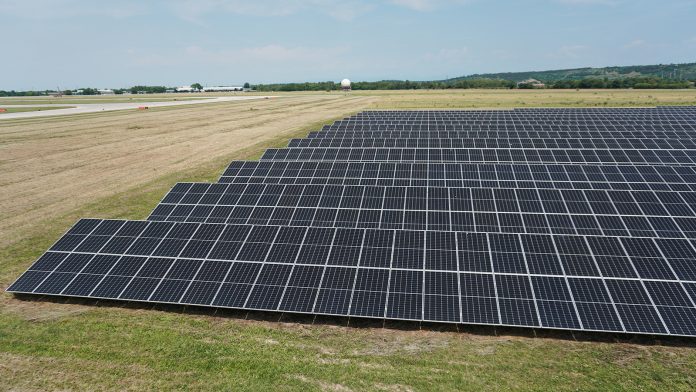by EH
In a pioneering leap towards sustainability, Trieste Airport has unveiled the largest photovoltaic plant currently operating in any Italian airport, coupled with a new fleet of electric vehicles, as part of an ambitious goal to achieve zero CO2 emissions by 2027.
Major Milestones Achieved
The initial major step in this green transition was the commissioning of a 3,143 kW photovoltaic plant by the end of March. This facility, integrated with 600 kW power batteries for energy storage and reuse, was soon followed in May by the replacement of airport operational vehicles with electric models. These moves mark significant progress towards the airport’s decarbonization.
“The green shift at Trieste Airport is another step towards reconciling air transport with the environment, aiming to eliminate CO2 emissions in line with European directives,” remarked Pierluigi Di Palma, President of Italy’s Civil Aviation Authority (ENAC).
Decarbonizing the Skies
Complete decarbonization by 2027 will involve eradicating CO2 emission sources related to the airport operator and maximizing the use of renewable energy. The photovoltaic plant, with its substantial energy production capacity, is central to this strategy, along with new energy-efficient installations planned for the terminal.
In addition to this, the airport is implementing further measures under the 2024-2027 Four-Year Intervention Plan approved by ENAC. These include investments to reduce energy dispersion at the terminal, install new air handling units, and deploy new heat pumps to enhance energy efficiency and significantly cut consumption.
Regional and European Support
The Friuli Venezia Giulia Region has played a pivotal role in supporting the airport’s green initiatives. The new photovoltaic plant is part of the Noemix project, which aims to replace regional public administration vehicles with electric ones, balancing their consumption with renewable energy produced at the airport. The excess energy produced is fed into the grid, contributing to the broader goals of the EU Horizon 2020 program.
“The photovoltaic plant at Trieste Airport, due to its size and capacity, is currently the most important in Italy within the airport sector, placing the regional airport at the forefront of national leadership in renewable energy,” noted Massimiliano Fedriga, President of the Friuli Venezia Giulia Region. “This project, co-financed by the Region, already ensures 75% of the airport’s energy needs and benefits the local community.”
Upgrading Ground Support
Further reinforcing its commitment to sustainability, Trieste Airport has upgraded its Ground Support Equipment (GSE) fleet with 29 new electric vehicles. These vehicles, essential for various airport operations, mark a significant step in reducing the airport’s carbon footprint. The airport secured funding of approximately €2.7 million from ENAC, supplemented by €911,691 in self-financing.
A Model for Future Airports
“This initiative is not just about reducing emissions,” emphasized Fabio Scoccimarro, Regional Minister for Environmental Defense, Energy, and Sustainable Development. “It’s about creating a smarter, more efficient, and sustainable model of mobility.”
Trieste Airport’s CEO, Marco Consalvo, echoed these sentiments, highlighting the dual objectives of increasing flight connections while achieving zero CO2 emissions by 2027. “The challenge is to preserve our pristine natural heritage while making our region more accessible,” he said.
The region’s efforts are further underscored by plans to establish electric car refueling stations at the airport, emphasizing a comprehensive strategy for environmental sustainability.





























